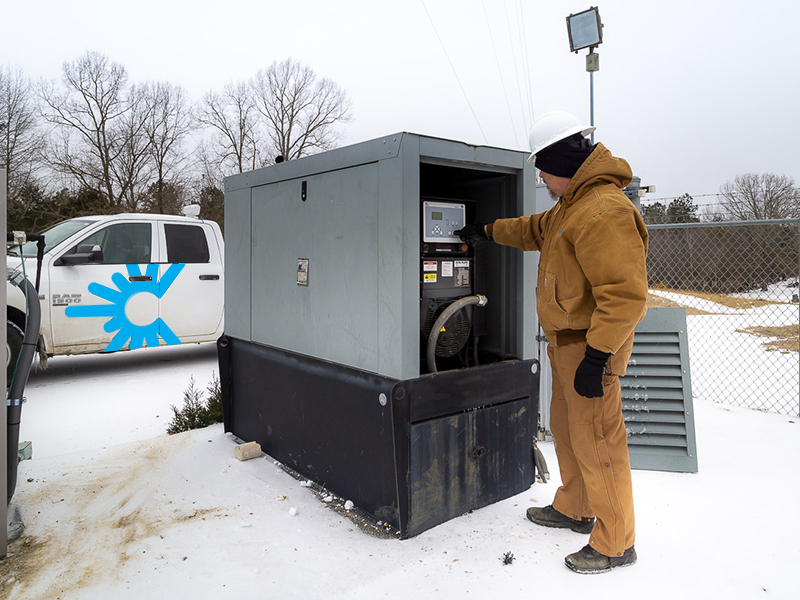
Photo: Eric Axley
Despite record-breaking cold temperatures and a layer of snow and ice that blanketed much of the state for a week, C Spire team members ensured the company’s wireless network and fiber infrastructure delivered reliable connectivity to wireless and fiber internet customers. As more than three decades of hurricanes, floods and winter weather have proven, the secret to customer service during trying times is preparation.
“To make sure we provide continual service to C Spire customers, we enable as much redundancy as possible,” says Mark Rigney, senior vice president of infrastructure at C Spire. “In extreme conditions like we had last week (Feb. 15-19), you’re going to have multiple issues occur at the same time. But none of our home or business internet customers lost fiber connectivity due to the winter storm." Only homes that lost power were without internet during the storm.
C Spire’s fiber infrastructure performs well under duress by design. While most fiber and cable internet providers string their lines alongside electrical lines on utility poles, C Spire bores underground and runs fiber lines underneath residential and commercial areas, which keeps it safe from inclement weather. Fiber is also much stronger than traditional copper; it can withstand up to 200 lbs. of pressure compared to copper’s 25 lbs., and fiber is durable and won’t break down from heat conduction.
Vijay Yerra, director of network operations and head of the C Spire Network Experience Center—mission control for the C Spire network, which monitors every line and tower 24 hours a day, 365 days a year—says the company uses data analytics, standardized processes and extensive system monitoring to stay on top of changing conditions and manage deployment of staff and other resources.
“The Network Experience Center coordinates the notification of power and site outages with field operations teams and directs our field technicians to these cell sites,” says Yerra. “We were engaged with Field Services since the start of this inclement weather event,” staying in constant communications through video conferencing and online chat.
All this coordination is designed to keep customers connected in a heavily rural state where cell sites are often located in remote areas. That fact also makes them vulnerable to commercial power outages that C Spire avoids by keeping industrial generators and backup batteries at most sites. Yerra says these generators played a critical role in keeping cell sites and transport equipment operational during a week that saw more than 200,000 power outages across the state. “Without fully functioning generators, hundreds of cell sites would have been isolated and unable to pass voice and data traffic.”
Planning for inclement weather outages happens as much as a week in advance of boots-on-the-ground preparations. For tropical weather systems, Rigney and his team run tabletop exercises to make sure the data facilities remain online and the personnel is in place to manage system stress, all the way down to having the right vehicles and making sure single parents aren’t scheduled for emergency calls. They also perform system checks for redundancy to verify backups and overbuilt components are in top working order.
While hurricane and tropical storms impact areas are generally easier to forecast from an earlier vantage, instances like the recent weeklong winter weather event are accompanied by continually shifting forecasts and models. Rigney’s team monitored the changes and gathered one last time on the Saturday preceding the Monday storm to verify the right amount of preparations were in place.
“Typically with an ice storm in our area you’re going to have a one-day impact, and then the next day the sun comes out and the roads are clear,” says Rigney. “Once we realized this was going to carry on for multiple days, that’s where the risk factor of this weather incident increased.
“The first day of an ice storm is not a big deal, because almost all our sites have generators, we have mobile generators for the sites that don’t have generators and we can pre-position those if we need to and make that call, and we have enough fuel to last several days. Once we realized we were going to have an extended period of this type of weather and it was going to hold for so long, that’s where we decided to activate our emergency procedures.”
When the snow and ice melted, though, the C Spire team—spanning network operations teams to field technicians and beyond—had weathered another storm and kept the lines of communications open for customers.
“The impact that we had to the network was relatively small compared to the extent of the event, when you look at the number of power outages and water outages that occurred throughout the state,” says Rigney. “We had huge impacts to the network overall, but we had redundancies in place that allowed us to continue to provide quality service for customers. When you look at the impact we had based on the extensive nature of the storm, I would say our team members did a very good job of making sure we gave our customers the service they needed throughout the state.”

















